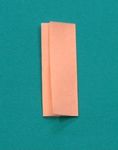Grab 'n Go Finger puppets
←
→
Transcripción del contenido de la página
Si su navegador no muestra la página correctamente, lea el contenido de la página a continuación
Grab ‘n Go
Finger puppets
1. Roll the Post It snugly around your finger. (Or fold it in thirds.)
Press flat. Make sure the sticky part is secure.
2. Fold one end down for the head. Crease.
3. Unfold. Cut two snips for ears. Or simply fold
the corners back or forward to create ears.
Fold the other corners in to create a chin or
snout.
4. Draw a face. Draw fur, whiskers,
spots, stripes, or whatever you want!
Supplies
Post-It note, pen, scissors (optional)
Learning Focus
Giving your child many opportunities to hear and create stories helps them develop language and
communication skills, while also promoting creativity.Scale it up Decorate your puppet with bits of paper, bottle caps, beads, yarn, cloth, foil, etc. Add hats, arms clothes, Make a puppet stage from a box. Or perform your puppet show from behind a book. Break it down What other things can be used to make a puppet? An old sock, a wooden spoon, a clothespin? The sky’s the limit. Mix it up Reading – Read one of your favorite books out loud. Use your puppets to act out the story. Writing – Write a script for your finger puppets to perform. Maybe a friend or family member can be one of the puppeteers. Math – When you fold your paper into thirds, how many sections will it have? What if you fold it in half? How big is your puppet’s head compared to the size of its body? How big is your head compared to the size of your body? When we compare numbers in math we are using ratios. A ratio says how much of one thing there is compared to another thing. Social Studies – Ask your parents if they remember making finger puppets or any other kind of puppets? Have you ever seen the giant puppets at the annual All Souls Procession in Tucson? Science – Some inventions start out as one thing and then get used for a totally different purpose. In 1968, Dr. Spencer Silver, a chemist at 3M Company, was trying to invent a super- strong glue. Instead he came up with weak glue. That could be seen as a mistake or as an opportunity! You could stick a piece of paper down , then pull it off and stick it somewhere else. No one knew what to do with this. Finally in 1980, 3M began selling Post It notes. A wallpaper cleaner was invented that ended up being used as Play Doh. Before it became a toy. the Slinky was invented as a way to stabilize equipment on ships. What other inventions did people find other uses for? Brain Builder Tip Puppets can support your child emotionally by giving them a “friend” to talk to. Your child can safely express their emotions through the puppet. Playing with the emotions of the puppets helps your child to better understand and manage their own emotions: important skills for success in school.
Grab ‘n Go
Títeres de dedos
1. Enrolla la nota adhesiva cómodamente alrededor de tu dedo. (o
dóblalo en tercios). Presiónala hasta que quede plana. Asegúrate de
que la parte adhesiva esté segura.
2. Dobla un extremo hacia abajo para crear la cabeza. Pliega.
3. Desplegar. Corta dos líneas diagonales
(como se muestra en la imagen) usando las
tijeras para crear las orejas . O simplemente
dobla las esquinas hacia atrás o hacia adelante
para crear orejas. Dobla las otras esquinas para
crear un mentón o un hocico.
4. Dibuja una cara. ¡Dibuja pelaje, bigotes,
manchas, rayas o lo que quieras!
Materiales
Notas adhesivas, bolígrafo, tijeras (opcional).
Enfoque educativo
Dale a tu hij@ muchas oportunidades para escuchar y crear historias. Lo ayuda a desarrollar habilidades de
lenguaje y comunicación, al mismo tiempo que promueve la creatividad.Amplíalo Decora tu títere con trozos de papel, tapas de botellas, cuentas, hilo, tela, papel de aluminio, etc. Agrega sombreros, ropa, haz un escenario de títeres con una caja. O realiza tu espectáculo de marionetas detrás de un libro. Simplifícalo ¿Qué otras cosas se pueden usar para hacer un títere? ¿Un calcetín viejo, una cuchara de madera, una pinza para la ropa? El cielo es el límite. ¡Modifícalo! Lectura – Lee uno de tus libros favoritos en voz alta. Utiliza tus títeres para representar la historia. Escritura – Escribe un guión para que lo interpreten tus títeres de dedo. Quizás un amigo o familiar pueda ser uno de los titiriteros. Matemáticas – Cuando dobles tu papel en tercios, ¿cuántas secciones tendrá? ¿Y si lo doblas por la mitad? ¿Qué tamaño es la cabeza de su títere en comparación con el tamaño de su cuerpo? ¿Qué tamaño es tu cabeza en comparación con el tamaño de tu cuerpo? Cuando comparamos números en matemáticas, usamos proporciones. Una proporción dice cuánto hay de una cosa en comparación con otra cosa. Estudios sociales – Pregúntales a tus padres si recuerdan haber hecho títeres con los dedos o cualquier otro tipo de títeres. ¿Alguna vez has visto las marionetas gigantes en la procesión anual de Todos los Santos en Tucson? Ciencia – Algunos inventos comienzan como una sola cosa y luego se utilizan para un propósito totalmente diferente. En 1968, el Dr. Spencer Silver, químico de 3M Company, estaba tratando de inventar un pegamento súper fuerte. En su lugar, se le ocurrió un pegamento débil. ¡Eso podría verse como un error o como una oportunidad! Puede pegar un trozo de papel, luego sacarlo y pegarlo en otro lugar. Nadie sabía qué hacer con esto. Finalmente, en 1980, 3M comenzó a vender notas Post-It. Se inventó un limpiador de papel tapiz que terminó usándose como Play Doh. Antes de que se convirtiera en juguete, el Slinky se inventó como una forma de estabilizar el equipo en los barcos. ¿Para qué otros inventos la gente encontró otros usos? ¡Apóyalo! Los títeres pueden apoyar emocionalmente a tu hij@ dándoles un "amigo" con quien hablar. Tu hij@ puede expresar sus emociones con seguridad a través del títere. Jugar con las emociones de los títeres ayuda a tu hij@ a comprender y manejar mejor sus propias emociones: habilidades importantes para el éxito en la escuela.
También puede leer
























































